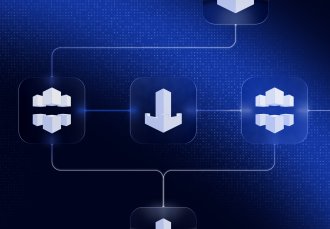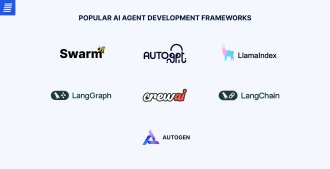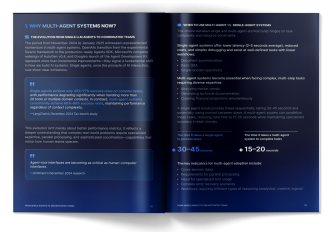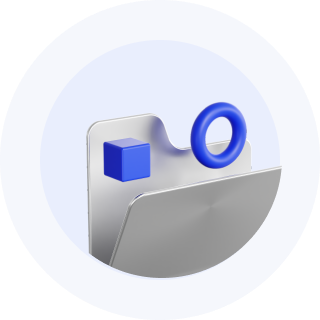
Contact us
Our team would love to hear from you.

AI agent frameworks are comprehensive toolkits that include built-in libraries, components, and functionalities to create the elements of single- and multi-agent systems: memory, planning, reasoning, tool calling, and decision-making. According to Glide, 47% of businesses are using AI agents in 2025, which makes the process of choosing a suitable agent framework extremely relevant for those who have yet to adopt them. In this article, we’ll explore seven state-of-the-art AI agent frameworks—along with their features, use cases, benefits, and limitations—to help you select tailored single- or multi-agent systems frameworks for your business ecosystem.
The right AI agent framework is key to building powerful assistants aligned with your specific business applications. But what components should a strong AI agent framework include? Here’s a breakdown:
To help you choose an appropriate instrument for your business ecosystem, we have compiled a compelling AI agent frameworks list. Our selection is based on criteria, such as time-to-market, cost-efficiency, single- or multi-agent orchestration, customization, and more. Here’s our extensive AI agent frameworks comparison:


This popular tool is used to build large language model (LLM)-powered single-agent systems with persistent memory, sound reasoning, and linear task execution. When combined with LangGraph, LangChain supports the development of multi-agent architectures.
| Pros | Cons |
|---|---|
| Open-source, flexible, customizable, and scalable | Third-party integrations can incur additional costs and lead to dependencies |
| Applicable across industries | Steep learning curve if developers aren’t familiar with LLMs and agent frameworks |
| Faster and more cost-efficient agent development with easier maintenance | Debugging can be time-consuming because of multi-step workflows |
Best for: startups to global enterprises looking to create high-quality, single-agent applications.
LangGraph is an extension of LangChain for developing stateful, multi-agent systems using LLMs.
| Pros | Cons |
|---|---|
| Open-source, flexible, and scalable | Limited customizations |
| Applicable across various verticals | Steep learning curve |
| Faster time-to-market | – |
| Dynamic decision-making enabled by stateful workflows | – |
| Reliable, fault-tolerant agents that improve efficiency and customer satisfaction | – |
Best for: enterprises requiring advanced, HITL-based multi-agent systems with state management and effective real-time decisions.

The CrewAI framework is designed to orchestrate teams of multi-agent solutions, where each agent has a distinct role, goal, and task. According to a report by eMarketer, 40% of Fortune 500 companies have already implemented CrewAI’s agents.
| Pros | Cons |
|---|---|
| Open-source and scalable | Enterprise-level features are commercial |
| Applicable in any industry | Has a complex initial setup |
| Supports agent adaptability under changing conditions | Requires additional customization and integration options for certain use cases |
| Accelerates implementation | – |
| Reduces development costs | – |
| Boosts productivity and improves decision-making through multi-agent collaborations | – |
Best for: research institutions experimenting with collaborative AI agents and small and mid-sized companies seeking to orchestrate crews of multi-agent systems for complex, coordinated tasks.
AutoGen is a framework for building enterprise-ready applications to achieve complex goals through multi-agent collaborations.
| Pros | Cons |
|---|---|
| Open-source, customizable, and scalable | Steep learning curve |
| Simplifies multi-agent development | Requires substantial computational resources, which can potentially increase development costs |
| Reduces development time | – |
| Caters to businesses across sectors | – |
Best for: large enterprises that need specialized agentic systems to solve intricate, multi-step problems.

We developed and integrated a voice assistant powered by generative AI (GenAI) agents connected to the client’s automotive infotainment system, streamlining interactions for Tesla drivers and increasing safety.
This pioneering framework helps create GPT-4 powered, single-agent solutions that make independent decisions.
| Pros | Cons |
|---|---|
| Open-source, versatile, and adaptable | Experimental tool that may not be fully effective in complex business scenarios |
| Suits industry-specific use cases | Complicated setup and configuration |
| Minimizes development time | Costly API calls to the GPT-4 model |
Best for: startups and small businesses looking to automate straightforward processes with AI agents.
LlamaIndex is a RAG-focused framework for developing autonomous knowledge assistants that effectively manage data-related tasks.
| Pros | Cons |
|---|---|
| Open-source, versatile, and flexible | Unsuitable for complex, orchestrated multi-agent workflows |
| Easy to use | – |
| Usable regardless of industry | – |
| Optimizes access to data | – |
| Enhances operational efficiency | – |
Best for: businesses of various sizes seeking autonomous agent solutions for quick and accurate data search and retrieval.
This agent framework is used to design orchestrated multi-agent workflows for educational and experimental purposes.
| Pros | Cons |
|---|---|
| Open-source, customizable, and lightweight with minimalist design | Unsuitable for production and real-world applications |
| Easy setup | – |
| Limited to educational, tech, and research and development (R&D) domains | – |
Best for: tech startups, R&D departments, and academic institutions that want to experiment with designing and coordinating multi-agent architectures.
Let’s explore how businesses can put AI agent frameworks into practice. Imagine the stakeholders of an e-commerce store were flooded with multiple customer queries. By implementing an LLM-powered agent specifically built with the LangChain framework, they can automate question-answering, remind customers about abandoned carts, qualify leads, schedule sales calls, initiate returns and refunds, and much more. As a result, the store sees a significant surge in productivity, boosts customer satisfaction, and increases sales—all through a single assistant built with the right tool. And as this e-commerce business grows, the AI agent effortlessly scales with it, managing more customers and performing more operations in real time.
There’s no universal AI agent development framework that caters to all company needs; the right solution depends on your specific business processes and objectives. Still, one thing is certain: the AI agent frameworks discussed in this article are viable alternatives to developing from scratch, allowing businesses to implement tailored assistants faster and more cost-efficiently. Whether you need expert guidance to select a suitable agent framework or want to build a custom, ground-up solution, EffectiveSoft’s specialists have the necessary expertise to support you. Get in touch today, and let’s bring your first AI agent to life—the one aligned with your use case!

AI agents are software programs that leverage LLMs and integrate third-party tools like APIs to perform tasks with little to no human oversight. With their advanced reasoning, planning, self-improvement, and decision-making capabilities, these solutions can complete assignments across sectors.
Single-agent solutions cater to small-scale tasks, such as knowledge management, ticket resolution, billing and paying support, and more. Multi-agent systems perform activities of varying complexity to achieve intricate, multi-step goals.
The various types of AI agent frameworks can be categorized based on agent design and functionality and include instruments that create simple reflex agents, model-based reflex agents, goal-based agents, utility-based agents, learning agents, and multi-agent systems.
The best AI agent frameworks in 2025 include LangChain, LangGraph, CrewAI, Microsoft AutoGen, AutoGPT, LlamaIndex, and OpenAI Swarm.
To select an appropriate AI agent framework for your business, consider your domain-specific use case, whether you need a single- or multi-agent architecture, the necessary levels of customization, the required deployment options, your integration needs, and scalability. Our comprehensive comparison of AI agent development frameworks will help you handpick the right tool that fits into your infrastructure.
Can’t find the answer you are looking for?
Contact us and we will get in touch with you shortly.
Our team would love to hear from you.
Fill out the form, and we’ve got you covered.
What happens next?
San Diego, California
4445 Eastgate Mall, Suite 200
92121, 1-800-288-9659
San Francisco, California
50 California St #1500
94111, 1-800-288-9659
Pittsburgh, Pennsylvania
One Oxford Centre, 500 Grant St Suite 2900
15219, 1-800-288-9659
Durham, North Carolina
RTP Meridian, 2530 Meridian Pkwy Suite 300
27713, 1-800-288-9659
San Jose, Costa Rica
Escazú Corporate Centre, Piso 6
40602, 1-800-288-9659